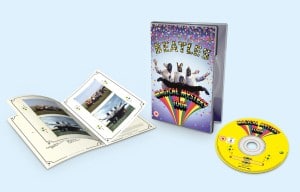“Let’s all get up and dance to a song that was a hit before your mother was born…”
A couple years ago, I watched in horror as a Project Runway designer registered blank when Tim Gunn made a reference to Sgt Pepper. Later in the episode, the designer confessed he didn’t know anything about the Beatles – he didn’t know any “music from the 40s.” It’s one thing to hear a child confess ignorance of the Beatles, but to hear it coming from a twenty-something sort of blew my mind. But I guess it does make some sense. I’m nearly 40 myself and the Beatles had broken up before I was born.
My earliest conscious memory of the Beatles was the news of John Lennon’s murder, and hearing nothing but the Beatles that day on the radio. But even as someone who hadn’t grown up with them directly, I’ve always regarded the group as an unavoidable fact of the music I listen to. Virtually every band I loved as a kid had learned to be rock stars by watching the Beatles. Virtually every singer I listened to would cite Lennon & McCartney as their heroes, as songwriting role models. It’s hard for me to fathom a generation far-enough removed from The Beatles that a reference to Sgt Pepper makes no more sense to them than a reference to Jose Jimenez. This, even as their label Apple/EMI has gone to great lengths in recent years to re-introduce the band’s work, most visibly via the magnificent Mono and Stereo remaster box sets of the group’s albums a couple years ago.
The latest Beatles artifact to appear in stores is the band’s decidedly less magnificent 1967 film Magical Mystery Tour, released this month on DVD and Blu-Ray. Originally broadcast on BBC as a holiday TV special in December 1967, the film, which runs just short of an hour is essentially a collection of music videos (before “music videos” were much of a thing) strung together by a series of improvised sketches framed as a colorful bus tour of the southern English countryside. There’s a little person taking pictures. There’s the jolly tour conductor and a blond seductress of a stewardess. There’s an unlikely romance between Ringo Starr’s large Aunt Jessie and a severe, uniformed fellow named Buster Bloodvessel. And for trivia-loving indie-rock fans, there’s a strip-tease set to a song called “Death Cab for Cutie”. On one hand, it’s hard not to agree with the British critics who panned it upon its first airing as a self-indulgent, self-referential waste of viewers’ time.
But it’s also hard to deny just how indelible some of its images have proven: there’s the bus, of course, but also the men in walrus suits, the motley parade through the fields, and a very young Paul McCartney as the “Fool on the Hill” skipping and jumping with boyish abandon, alone against a towering backdrop of mountain evergreens. This is the first time I’d ever seen the film as a whole, but these images all felt sweetly familiar to me – and I couldn’t for the life of me tell you where or how I’d ever seen them before (except maybe for that “Fool on the Hill” sequence which had been a staple on VH-1’s 60s themed music video show “My Generation” in the mid-to-late 80s). Even the sequences that weren’t specifically familiar reminded me – in their use of superimposed images, their visual non-sequiturs, their willfully haphazard editing – of videos by 80s college rock acts like Robyn Hitchcock and I.R.S.-era R.E.M.: one more way the Beatles, long broken up, were informing my (generation’s) experience of music in the 80s.
For his part, in the DVD’s commentary track, Paul McCartney agrees the film was self-indulgent, but he suggests that self-indulgence is part of its charm, likening it to a collection of home movies – only completely dreamt up home movies, drawn largely from the guys’ nostalgia for their own childhoods. He has a point. I love, for instance, how the Beatles imagine a world in which you hear Beatles songs played on carousel organs at country fairs and village festivals: “She Loves You” as the song kids don’t hear on the radio, but whose melody they come to know subliminally while playing midway games. Half a century later, that isn’t too far from what the Beatles’ music has become.
My favorite part of the film is when the Beatles feign a classic movie musical production number with the closing “You Mother Should Know.” There’s John, Paul, George, and Ringo, goofing in white tailed tuxedos, swaying and gesturing through the most rudimentary choreography, back and forth in semi-unison, barely stifling the giggles at the nostalgic silliness of it all as a cast of thousands (or at least dozens and dozens) parades and dances along with them. It’s the most unabashedly happy moment of the Magical Mystery Tour, especially coming at a time in the band’s history where the happiest days were largely past and the (metaphorical) wheels were about to come off.
Whatever flaws the film itself may have, its presentation in this reissue is loving and detailed, with a slew of extras including Paul McCartney’s commentary, a making of video, and videos of contemporaneous TV appearances. It also comes with a lovely booklet insert with full credits and lots of photos. All told, a must have for any Beatles fan (though maybe not the best first impression of the band for all those twenty-somethings who don’t listen to “40s music”.)
– Paul Lorentz

